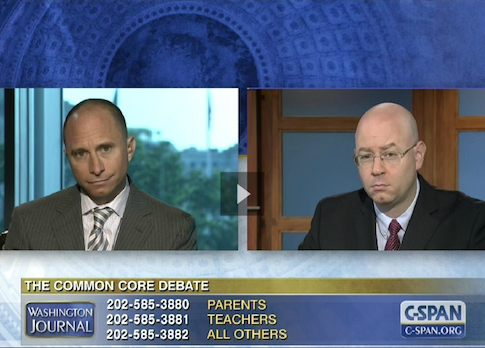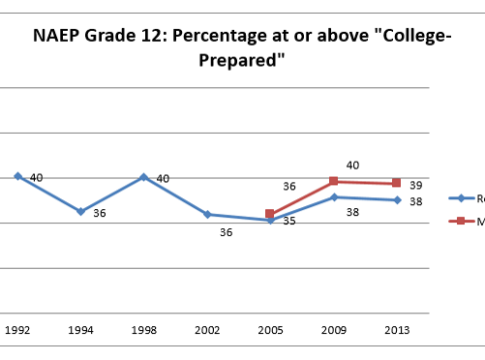In May, a new organization called Learning Heroes released a survey with a startling finding: 90 percent of parents believe that their children are performing at “grade level” or higher in their schoolwork. Setting aside the debate over what “grade level” even means, by any reasonable definition many of these parents, if they are being frank with the pollsters and themselves, are sorely misinformed. Consider that only about a third of U.S. teenagers leave high school ready for credit-bearing college courses.
 Providing a more honest assessment of student performance was one of the goals of the Common Core initiative and the new tests created by states that are meant to align to the new, higher standards. And, as reported in these pages, those tests are much tougher than they used to be, with failure rates in many states approaching those reported on the National Assessment of Educational Progress (see “After Common Core, States Set Rigorous Standards,” features, Summer 2016). Yet on the heels of their first administration in the spring of 2015, and the reporting of results in the months following, parents seem to be as ill-informed as ever. (The 2016 Education Next poll indicates that the lower proficiency rates haven’t shaken parents’ view that their schools deserve As and Bs, either.) Why might that be? And what could policymakers or entrepreneurs do to change that?
Providing a more honest assessment of student performance was one of the goals of the Common Core initiative and the new tests created by states that are meant to align to the new, higher standards. And, as reported in these pages, those tests are much tougher than they used to be, with failure rates in many states approaching those reported on the National Assessment of Educational Progress (see “After Common Core, States Set Rigorous Standards,” features, Summer 2016). Yet on the heels of their first administration in the spring of 2015, and the reporting of results in the months following, parents seem to be as ill-informed as ever. (The 2016 Education Next poll indicates that the lower proficiency rates haven’t shaken parents’ view that their schools deserve As and Bs, either.) Why might that be? And what could policymakers or entrepreneurs do to change that?
First, let’s acknowledge the challenge at hand. Conscientious parents are constantly getting feedback about the academic performance of their children, almost all of it from teachers. We see worksheets and papers marked up on a daily or weekly basis; we receive report cards every quarter; and of course there’s the annual (or, if we’re lucky, semiannual) parent-teacher conference. If the message from most of these data points is “your kid is doing fine!” then it’s going to be tough for a single “score report” from a distant state test administered months earlier to convince us otherwise. After all, who knows my kid better: his or her teacher, or a faceless test provider?
It’s also true that those score reports have typically been about as easy and appealing to read as auto repair manuals. But what if they were written in plain English, and supplemented by additional, engaging resources online? To their credit, some states have been testing this very proposition.
The Partnership for the Assessment of Readiness for College and Careers (PARCC), for example, worked with communications professionals to develop its score report—used by most participating states—and it’s a big step up from the mind-numbing obscurities of the previous generation. Straightforward language, intuitive symbols, and pleasing colors invite parents to take in key information about their child’s performance. A companion web site, UnderstandTheScore.org, allows them to dig deeper.
Some nonprofit organizations are trying to help parents make sense of their children’s test scores, too. GreatSchools.org, through its GreatKids initiative, offers a Test Guide for Parents that walks families through score reports, what the results mean, and how they can help their kids do better.
As promising as these new score reports and web sites are, however, they are still just works in progress. They all have a tendency to soft-pedal the bad news to parents. The resources for elementary and middle school students and parents only go so far, saying that kids aren’t ready for “further study” or “the next grade level,” not that they aren’t on track for college (or for getting out of their parents’ basements). They also could be a lot more user-friendly; the PARCC report, for instance, still provides an overwhelming, confusing amount of information. Elegant simplicity must be the coin of the realm.
Clearer, more courageous language would be a step in the right direction. But so would making it real. Surveys show that almost all American kids aspire to attend college. Why not say explicitly whether they are on track to achieve that goal?
Several states already provide “predictive analytics” to teachers and school leaders regarding students’ likelihood of future success. In Ohio, for instance, educators can see a prediction for the eventual ACT scores of their 6th-grade pupils, based on their annual standardized test results. (Of course, “college readiness” entails much more than standardized test scores, but they are key components.) Why not include such predictions on the score reports themselves, and list the kinds of colleges the student is (or is not) on track to attend? Another idea for entrepreneurs: build a web site where students or their parents can enter their test scores themselves, and provide a prediction for the types of colleges where they are likely to gain acceptance. If enough families see that their child’s likely future includes remedial education, then maybe they will start pushing their K‒12 schools to do more to help prepare their kids for success at the postsecondary level.
And what if these parents do get the message that their kids aren’t doing well? What should—what can—they actually do about it? Understand the Score and GreatKids offer some ideas, as does Learning Heroes via its “readiness roadmap.” But, once again, these suggestions tend to be of the soft, fuzzy variety. Nobody wants to tell parents to grab a pitchfork and march down to their school demanding an explanation for the lofty-yet-false grades their kids have gotten for years on end. Maybe they should.
One constructive approach comes from the College Board, which forged a partnership with Khan Academy to provide free tutoring to students linked to their PSAT results. When kids get their PSAT scores, they can instantaneously link to Khan Academy modules that target areas where they need additional help. More than one million teenagers have taken advantage of the offering so far. Why couldn’t states (or districts) do the same? Parents may be more likely to take bad news seriously if it accompanies resources to help their children improve.
Still, it may be that test-score results will never convince parents that their kids need to step it up, at least until schools stop handing out As and Bs to students who aren’t on track for success. Maybe what’s needed is a full-court press to reform teachers’ grading toward candor and honesty rather than inflation and good feelings. An idea worth considering, though one that might take some time to take root.
Right now, we have higher standards and tougher tests in most states. Shouldn’t we at least try to use them for one of their intended purposes: to close the gap between college aspirations and college readiness? It just seems like common sense.
Michael J. Petrilli is president of the Thomas B. Fordham Institute and executive editor at Education Next.
This article appeared in the Winter 2017 issue of Education Next. Suggested citation format:
Petrilli, M.J. (2017). Common Confusion: Most kids in America aren’t on track for success. Why don’t they and their parents know it? Education Next, 17(1), 84-85.





